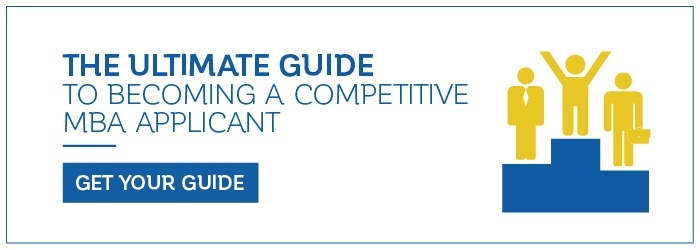

“What Does Your Work Experience Reveal About You in Your MBA Application” is excerpted from MBA Admission for Smarties: The No-Nonsense Guide to Acceptance at Top Business Schools, by Linda Abraham and Judy Gruen.
MBA Smarties need to strategize their MBA applications before actually filling out any applications or writing any essays. Because I’m such a firm believer in the “ready, aim, fire!” philosophy of school applications (and not the reverse), the first three chapters of this book have focused on what I consider the three essential steps in this strategic process:
1. Analyze your career goals and educational needs.
2. Research programs you might be interested in to see which will help you achieve your goals and suit your learning style.
3. Assess your qualifications as an MBA applicant.
All too often, applicants miss one or more of these initial steps, which can lead to a scattershot or poorly thought out approach to the applications. Without performing this due diligence, you are likely to apply to schools for the wrong reasons, such as the star quality of a school name, wanting to live near a significant other who works in that city, or having heard that the school really goes for candidates like you. But applying to schools where you don’t fit is just a big waste of time, energy and money. Following a clear roadmap that is based on logic and facts, on the other hand, enhances your marketability as an applicant. It shows you know what you’re about and what you are not about. It shows that you took the time to figure out where you belong. It’s just smart.
Now it’s time to put together the pieces of this analysis and research and get to the more exciting part of the application process: picking your schools. You can start by graphing out two big circles: One contains the names of the schools you want to attend. The other contains the names of the schools likely to want you in return. The schools in both circles are the ones you should apply to, or at least choose from. The intersection of these two circles becomes the universe of schools you should consider.
Back in Chapter 2 you learned what a wealth of information is available on the websites of most well-regarded MBA programs. Now is a good time to revisit those websites to look at the class profiles and confirm that there is an overlap between your qualifications and the typical profile of admitted students at the schools that support your goals. The class profiles will show you the ranges and averages of GMAT scores, GPAs and years of work experience. Do your numbers fit in those ranges? If your quant profile is a “go,” check to see if you are also a match qualitatively. After all, it’s not enough to know that you can match brain cell for brain cell among your future classmates. You want to know that you’ll be simpatico with the kinds of students those programs attract. How can you judge this sort of complementariness? Look at text or video profiles of students that often appear on school websites or, student blogs (sometimes hosted by the schools). Can you imagine yourself working, studying and collaborating on projects happily with these folks?
Are you a fit or a misfit?
Let’s look at a few profiles of fictional applicants and see how well they fit with the schools they have chosen:
SHANNON. She’s got excellent work experience in new media marketing and development and a competitive GPA (3.8) and GMAT (710). Having lived her whole life in the cold Midwest, Shannon found the West Coast’s sunnier climate and U.C. Berkeley (Haas’) proximity to San Francisco an irresistible lure. Given her professional chops and strong stats, she is optimistic about her chances. But a closer reading of Haas’ latest curriculum enhancements revealed the school’s increased emphasis on what it calls “Leading Through Innovation” and a culture emphasizing four core principles: 1) question the status quo 2) confidence without attitude 3) students always 4) beyond yourself. Despite her strengths, Shannon has no community service and limited leadership experience, making it a tough sell to show she belonged in a program so heavily geared toward the idea of leadership and “beyond yourself.” Misfit.
CHARLIE. Since his college graduation, Charlie has worked in real estate development and wants an MBA to move up in his real estate development firm. His girlfriend is a student at London Business School, and Charlie is thinking about INSEAD because it is only a one-year program. Trouble is, INSEAD has few relevant courses in real estate development. As with Shannon, Charlie’s other strengths in work experience and good stats cannot compensate for a mismatch of his career goals and school strengths. Misfit.
STEPHANIE. An aspiring management consultant with decent entry-level experience in a small management consulting firm, Stephanie plans to apply to Tuck, Ross, HBS, Kellogg and Darden. But her 650 GMAT puts her at a serious disadvantage. All those schools, as well as most management consulting firms recruiting from them, will be looking for GMATs of 700 or higher. Misfit.
DANNY. A career changer moving from IT to financial consulting, Danny prepared for the change by taking more quant and finance classes at a local college and volunteering as a financial counselor at a community service agency. With his 720 GMAT and 3.7 GPA, he applied to five programs, including Wharton and MIT Sloan. Denied acceptance by all schools, he reapplied to MIT Sloan the following year, showing additional growth in his financial consulting experience. Fit.
As these examples show, the idea of “fit” is something all schools take seriously. Before you apply, make sure to read student profiles on school web sites, read student blogs and watch student interview videos to help you assess whether you’re a fit with your likely classmates, academically and personally.
For personalized advice tailored just for you, check out our MBA admissions consulting and editing services and work one-on-one with a pro who will help you discover your competitive advantage and use it to get accepted.
Related Resources:
• Fitting In & Standing Out: the Paradox at the Heart of Admissions, a free guide
• Are You Targeting the Right MBA Program for You?
• Which B-School is the Best for You?
The post Are You a Good Fit for Your Target MBA Programs? appeared first on Accepted Admissions Blog.



No comments:
Post a Comment